Health
- Animals, Bees, Birding, Building and Landscaping, Chickens, Cob, Compost, Composting toilet, Fungus and Mushrooms, Gardening adventures, Giving, Health, Heirloom Plants, Hiking, Houses, Hugelkultur, Humor, Living structures, Natives, Natural cleaners, Other Insects, Permaculture and Edible Forest Gardening Adventures, Pets, Photos, Predators, Quail, Rain Catching, Recycling and Repurposing, Reptiles and Amphibians, Seeds, Soil, Vegetables, Water Saving, Worms
Special Tours for Aug. and Sept., 2014
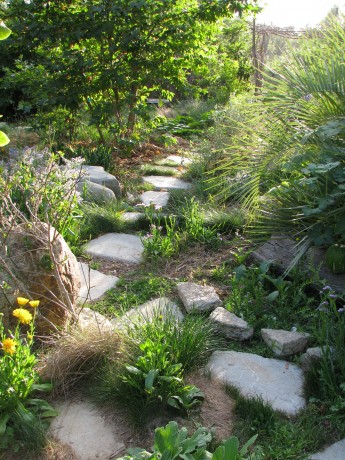
Come take a tour of a food forest! Normally tours of Finch Frolic Garden are held by appointment for groups of 5 – 15 people, Thursdays – Mondays. Cost is $10 per person and the tour lasts about two hours. By popular demand, for those who don’t have a group of five or more, we will be hosting Open Tour days for the first 15 people to sign up in August and September. They will be Sunday, August 10 and 24, Sept. 7 and 21, and Thursdays August 7 and 28, and Sept. 11 and 25. Tours begin promptly at 10 am. The tours last about two hours and are classes on basic permaculture while we tour the food forest. I ask $10 per person. Please reserve and receive directions through dianeckennedy@prodigy.net. Children under 10 are free; please, no pets. Photos but no video are allowed. Thank you for coming to visit! Diane and Miranda
-
Fruit Flies – How To Be Rid of them Naturally

A jar, plastic and ACV. Works like a charm. It is fruit season and citrus and stonefruit are becoming ripe in the garden. When the fruit comes to the kitchen, and particularly when the peels and pits go into my open compost bucket, fruit flies appear as if by magic. It is amazing how quickly they show up and how quickly they reproduce. Fruit flies are busy laying eggs in any spot on any fruit or juice vegetable such as tomato. Gross. Here is a quick and inexpensive method of trapping and -unfortunately- killing the little things. I don’t like to kill anything, but I don’t know of a way to get around this, even when I drape towels over the fruit.
Take a small canning jar or baby food jar – something like that. Use the rim of the lid of a canning jar, or just a strong rubberband. You’ll also need a small piece of plastic to cover top of the jar; you can reuse some cellophane or part of an old plastic bag.
Fill the jar only about halfway with apple cider vinegar – not white distilled vinegar. Place the plastic over the top and secure with the lid rim or a rubber band.

A fruit fly finding a way in. Take a toothpick and prick tiny holes in the plastic. Set the jar near where the fruit flies accumulate and forget about it. Be sure to remove other lures such as old kitchen scraps or fruit, or cover it with dishtowels. That’s that. The flies swarm to the jar and eventually disappear into it and can’t get out.
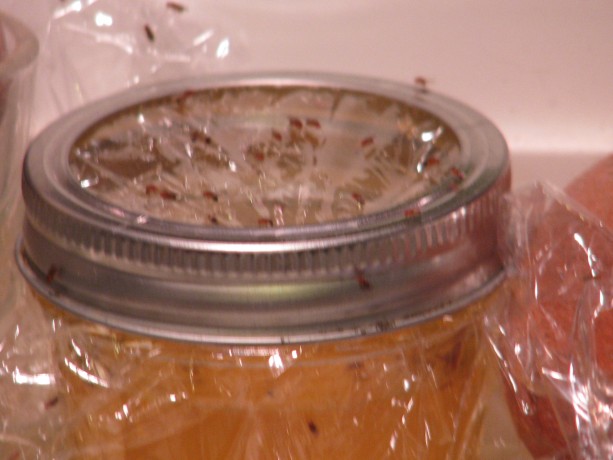
A kind of blurry photo of lots and lots of fruit flies queuing up to get inside. - Animals, Bees, Birding, Chickens, Cob, Compost, Composting toilet, Fungus and Mushrooms, Gardening adventures, Health, Heirloom Plants, Hiking, Humor, Living structures, Natives, Natural cleaners, Other Insects, Permaculture and Edible Forest Gardening Adventures, Pets, Photos, Ponds, Predators, Quail, Rain Catching, Reptiles and Amphibians, Seeds, Soil, Water Saving, Worms
Finch Frolic Facebook!
Thanks to my daughter Miranda, our permaculture food forest habitat Finch Frolic Garden has a Facebook page. Miranda steadily feeds information onto the site, mostly about the creatures she’s discovering that have recently been attracted to our property. Lizards, chickens, web spinners and much more. If you are a Facebook aficionado, consider giving us a visit and ‘liking’ our page. Thanks!
-
Good-bye, Sweet Belle: The Death of a Crossbill Hen

Belle in her bath. Last Tuesday when I opened the chicken tractor to let the girls come bounding and clumsily flutter out for their breakfast, Belle our genetic crossbill Americauna didn’t emerge with her usual energy. I make a custard of blended chicken food, whole eggs, greens and fruit, cooked and cooled, to feed her. The custard contained all the goodies the other hens had, but was easier for her to scoop with her twisted beak. I’d fill her dish before I come down to ‘do the hens’, and she was fed first. Her dish was placed into the top of the quail hut with the door propped open so only Belle coud get in and out; the other hens loved to share her food otherwise.
Although Belle ate vigorously, she never gained full body weight. Her beak prevented her from eating well enough. Out of every five scoop attempts at the custard I’d say that she’d get one mouthful. Yet she was always perky, always running around interested in everything, and even tried dominance tactics over some of the other girls. They’d let her since she wasn’t a threat to any of their food.
Because Belle’s eating habits were very messy her neck and head feathers were straggly, and combined with her twisted beak gave her a comical, slightly crazed look. Because she was handled so much when she patiently allowed us to trim her beak and nails, and give her a bath, she was very friendly. She’d jump on our backs and shoulders any time we’d bend over in the coop. She’d enjoy being carried around. She was very spoiled. We’d read posts where owners of crossbills, who didn’t cull them but kept them as pets, had them live up to ten years and lay eggs. It was all dependant upon to what degree their bills crossed, and Belle’s became severe.
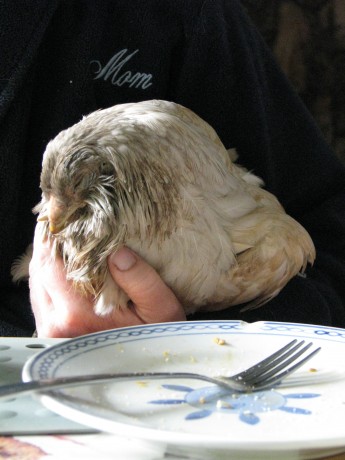
About a month ago we noticed mites on her, something that is common on hens, and gave her a good bath and treatment with food grade diotomaceous earth. The FGDE works immediately and is very effective and safe. Otherwise she was bright, fun and perky, burrowing under the other girls on the roost overnight to cuddle.
Tuesday Belle was slower to come around, and didn’t want to eat. A hungry hen not wanting to eat? Bad news. We immediately took her into the house. It was a cold day, so we made her comfortable next to a space heater. On inspection we discovered that she had mites all over her. We also checked the other hens right away and they were all okay, so apparently Belle’s diminishing health encouraged them to reproduce, and as she couldn’t groom herself she was stuck. We coated her with FGDE, not wanting to bathe her while she was feeling poorly since it was a cold day, and dropper fed her food. She showed some energy and wanted to run around, and took the food hungrily.
It was time to trim the Christmas tree, and my daughter put Belle under her sweater to keep her warm and comforted as we worked; Belle loved being cuddled and held, so she put up no resistance, but we could see that she was ill.
We brought in the cage that we used for Viola the ex-house chicken, and for all of our patients, and tucked Belle in for the night next to the space heater.
In the morning Belle was sitting very still. I knew that she was nearly gone. Just after waking my daughter, Belle died as she held her. She is buried outside our bay window where we watch birds, close to the house.
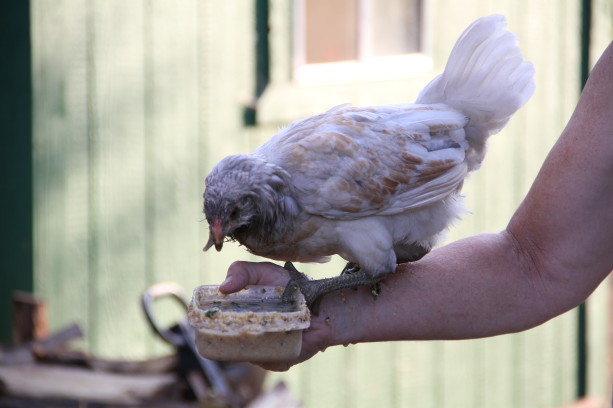
Belle usually can’t wait until she’s served. Birds are so tricky. They can seem perfectly fine, but when they show illness it is usually too late and the end comes quickly. There is little you can do for them besides keep them comfortable. Neither of us expected Belle to pass away; she showed no previous symptoms and was her usual plucky, fun self. Something internal gave way from slow malnutrition caused by that darned crossed bill and her inability to eat enough. On reflection I don’t think that Belle had a bad life. She ate enough to not be hungry all the time, and her custard gave her ease of eating. She was much loved and spoiled. Her end was quick, which was merciful and not granted to many of us. But Belle will always be remembered.

Ah haz a friend! - Animals, Chickens, Cob, Compost, Composting toilet, Fruit, Gardening adventures, Giving, Grains, Health, Herbs, Houses, Hugelkultur, Humor, Living structures, Natives, Natural cleaners, Permaculture and Edible Forest Gardening Adventures, Ponds, Rain Catching, Recipes, Seeds, Soil, Vegan, Vegetables, Vegetarian, Worms
San Diego Permaculture Convergence, Nov. 9 – 10, 2013
There is a fantastic, information-packed permaculture convergence coming up at the beautiful Sky Mountain Institute in Escondido.
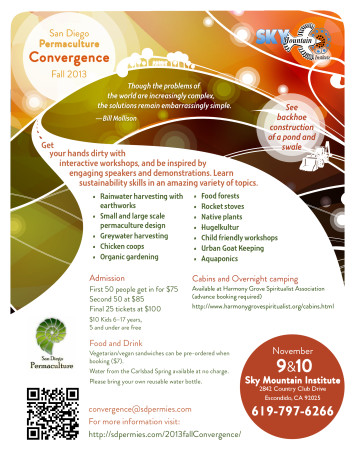 It will be two days packed with great information for a very reasonable price; in fact, scholarships are available. Check out the website at convergence@sdpermies.com. On that Sunday I’ll be teaching a workshop about why its so important to plant native plants, how to plant them in guilds using fishscale swales and mini-hugelkulturs. Come to the convergence and be inspired!
It will be two days packed with great information for a very reasonable price; in fact, scholarships are available. Check out the website at convergence@sdpermies.com. On that Sunday I’ll be teaching a workshop about why its so important to plant native plants, how to plant them in guilds using fishscale swales and mini-hugelkulturs. Come to the convergence and be inspired! - Compost, Gardening adventures, Health, Hugelkultur, Other Insects, Permaculture and Edible Forest Gardening Adventures, Soil, Vegetables, Worms
Don’t Clean Up, Dig It In!

Use old vegetables to grow new ones! Tomatoes, eggplant, peppers, fennel, carrots, string beans, three kinds of basil, and probably other things I’ve forgotten about! In January of this year I wrote about Lazy Composting. Frost had killed off sweet potato and tomato vines,
and the soil in the raised garden beds were becoming very low.

- Soil level is very low on the raised beds.
Instead of hauling all the vines to the compost heap or bin, I thought I’d create soil in place. The raised beds are lined with chicken wire to protect veggies from gophers. Although I didn’t want to disturb the microbes and fungus in the soil, I dug out half the beds down to the wire.
Then I layed all those vines right on the soil and covered them up.
Then I did the other half…
- Spent tomato vines, with some green ‘maters still attached.
… and then did the other bed. Any thick stalks in other beds which didn’t need extra soil I simply cut close to the ground so that their roots can decay in place and feed the wormies.
I sprinkled the whole thing with a little Epsom salts for the magnesium sulfate, and a little sugar to start the disturbed microbes feeding and reproducing heavily, which would cause them to decompose the vines more quickly.
In one bed I planted cold weather crops right away; peas, brassicas, garlic, onions and more. I am a firm practicioner of polyculture, or integrated gardening , which means that I plant an assortment of seeds of plants which will help each other in small areas instead of planting all one thing to a bed. I can still plant a row of peas so that I can string them up easily, but I’ll plant all kinds of other plants around them. Usually I don’t plant in a line at all anymore, but rather stake the plants as they need them. Often they’ll use taller plants as support. This is why planting peas and sweet peas next to trees and bushes is a great idea (they fix nitrogen in the soil which helps the tree).
In the other bed I waited to plant until March when the weather warmed up, because I was planting early summer crops. Here it is the beginning of September, and here are the beds, still producing. Even the winter veg one.
In the bed to the right there is a yellow current tomato blocking the view, and growing into the tree. You can see a Japanese eggplant, and behind it the red is a pepper. Under the tomato and along the bed are three kinds of basil, many string bean plants, some of the sweetest carrots we’ve grown, fennel (one of which we allowed to be the host plant for the Anise Swallowtail, which ate the tops. The bottom of the fennel, which is the part we eat, will still be harvestable). In the bed to the right is the January plants still alive and kicking. Collards, kale, garlic, celery, onions, brussels sprouts, kohlrahbi and more. We’ve harvested most of the garlic and onions. We’ve harvested kale, collards and celery by cutting leaves and allowing the plant to continue to grow. The stalks are now so thick that it is hard to cut them. Out of season, these plants have had attack by cabbage moths and other bugs, but because of the integration of plants and the health of the soil, they’ve bounced right back. I’m harvesting the plants now to feed to the chickens so that I can use the bed for something else soon.
So what happened? A teaspoon of great soil has a billion microbes in it, a million fungi, tens of thousands of amebas, bacteria and all kinds of things we don’t even know about yet. This is a good thing. This is the secret to continued life on this planet. Healthy soil doesn’t wash away, doesn’t erode, feeds the underground waterways, grows excellent food for healthy wildlife and healthy humans. If we feed the soil, we save the planet. That simple. That means no Roundup, no GMOs, no chemical (even organic) fertilizer. Just compost. Very cheap and easy.
Vegetables tend to like a soil that is heavier in bacteria than in fungus, although both should be present. Woody plants such as bushes and trees tend to like a more fungal soil. The vines that I buried had both dry (stems) and wet (green leaves and tomatoes) on them. The stems made the fungus flourish in the soil, and the green bits made the bacteria active. There wasn’t enough matter to become anaerobic, or to rob nitrogen from the soil. The vines weren’t compacted so lots of soil surrounded all the parts, aiding in quick composting and keeping the soil aerated. Water could be absorbed better as well.
If you are starting a garden and want to buy compost, be careful of what stores sell you. In August I was asked to look at a few raised beds that hadn’t succeeded. The soil was low in the beds, there were a few straggly pepper plants, a poorly tomato and some brassicas of some sort which were so stunted that they were just green balls of leaves. When I pulled one up there was white stuff on the roots. A couple of strawberry plants looked very healthy but unproductive. I tried the soil and couldn’t get my finger into it because the roots from those poor peppers had made a thick mat just under the surface of the dirt well beyond their dripline. Two major things were wrong. One was the dirt in the beds. Splinters of shredded wood made up the bulk of it. The woman who had asked me to look at the beds said that she had described her project at Home Depot and they’d recommended two kinds of bagged stuff. I say stuff, because it isn’t soil. What they recommended would be appropriate for hardwoods such as bushes and trees, or acid-loving plants. That is why the strawberries were healthy, only they were in the full sun in a searing hot place and would have done much better under the shade of other plants. I showed the white stuff on the brassicas to her; it was fungal net, which showed the high fungal activity in the soil. Perfect for trees, not perfect for vegetables. Also the brassicas are cold-weather plants and just won’t develop in our summer heat here in San Diego County. They should be planted from October through the beginning of March. The spongy soil… honestly, I’ve never before felt root mat so thick that I couldn’t wiggle my finger into the soil… was the result of desperate plants and poor watering. A custodian would occasionally hose water the beds, which meant that he’d shoot some water on them for a few minutes every day or so. This topical water didn’t sink into the bark-heavy soil. It was only enough to water the top, so the plant roots couldn’t go deep. It was often enough that the plants didn’t die entirely, but survived stunted and striving for water and nutrition that the fungal soil wasn’t providing. Vegetables (and roses!); indeed, most plants except grasses and seedlings, need deep watering less frequently. This allows the roots to go where they want to go, deep into the ground where they can mine nutrients and stabilize the plant. My advice for her was to dig in the few plants that were there, use the compost in the compost bin next to the beds, even if it wasn’t decomposed and add some vegetable-friendly soil to the beds to bring up the heighth. I recommended mixing seeds and scattering them, making sure she planted winter crops, not corn or tomatoes. I also recommended a long watering twice a week; none when it starts raining. If it ever does.
Recommending permaculture techniques to people makes me want to work in the garden! That is because there is so much life, so much success, so many happy surprises and such great feelings that come out of naturally planted gardens. Rows of veggies look so neat and peaceful, but beds chock full of veggies are more fun, better tasting and far more productive.
I just wanted to follow up on the old post about digging in the vines and show you how well the plants did. I have never fertilized these beds after burying the vines and sprinkling on the Epsom salts and sugar. All this growth is due to the happy microbes making nutrients available to the vegetable roots. If you think about it, plants in the wild shed their seeds and then either completely die off or drop leaves. The seeds naturally grow up through the debris of the last generation. Makes sense, doesn’t it?
When these beds are done (if they ever are! They keep producing!) I will practice no-dig gardening on them and simply cut all the plants at the soil surface and drop the tops. I’ll plant seeds for winter crops right in among the debris of the summer crops. They’ll use the nutrients, shade and support of the old crops to grow. October is a good planting time for winter crops because the weather finally changes and the daylight hours are shorter which these plants need. What to plant? Potatoes, garlic, onions, Brussels sprouts, cabbage, peas, broccoli, cauliflower, rhubarb, kohlrabi, celery and much more. Cover crops when it frosts and allow good drainage for the potatoes when it rains. Be sure if you buy starter sets that they are guaranteed organic! Best of all plant organic seeds… they do the best of all and are the best value.
Have a happy, easy Fall garden!
- Animals, Bees, Chickens, Health, Natural cleaners, Other Insects, Permaculture and Edible Forest Gardening Adventures, Pets, Quail, Worms
DE for Birds, and More About Chickens
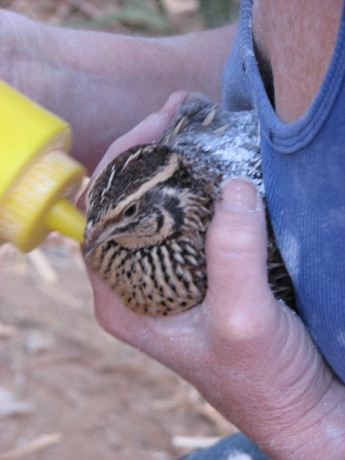
A little mustard with your quail? Cleopatra being treated. I’ve written about using Food Grade Diatomaceous Earth around plants to keep down ants and other sectioned insects. It is also used around the feet of my bee hives; as long as it isn’t where bees and other beneficials go it won’t hurt them because it has to be on the bug to work. I’ve also used FGDE around my cat’s bedding to kill hatching flea eggs, and have rubbed it into their fur. It is scentless, edible (will help kill interior parasites when eaten), tasteless, and the food grade is so fine that it won’t hurt your lungs if you breathe it in, although if you have lung conditions you should wear a mask. More about FGDE in a minute.
Some of our laying hens have difficulty laying eggs recently. Chickpea we found panting on the ground in a wet spot, with ants on her. She had a soft-shelled egg break inside of her.

Madge in the house cage, recooperating. Madge, our partially blind RIR passed a soft shelled egg, then was ill for a day when she passed a broken shell. Warm Epsom salts baths and time spent in the house cage with a heating pad helped both of them. Because of the threat of infection I used some of the Cephalexin left over from our dog (divided into small doses) on both of them and they recovered. My daughter finally deduced that in the mornings when the pullets and hens were released the big girls ran over to eat the chick mash. It probably tastes better than the lay pellets, and more importantly in their little brains it kept the pullets from eating it. Even with the supplemental oyster shell the big girls were probably not getting the calcium and other nutrition their bodies needed to make good eggs. It was time to switch the small girls to lay mash anyway, so I did and yesterday we had all four of our laying hens lay eggs… first time in a long time!
While we were bathing Madge in the sink for her illness, my daughter noticed mites on her. Now a few mites are usual on everyone and everything. When you can see several on the skin when you blow on the feathers, then you have a problem. She wasn’t having a problem, but at that time we still didn’t know what was wrong with her. After she was better we instituted FGDE Day in the Fowl Fortress.
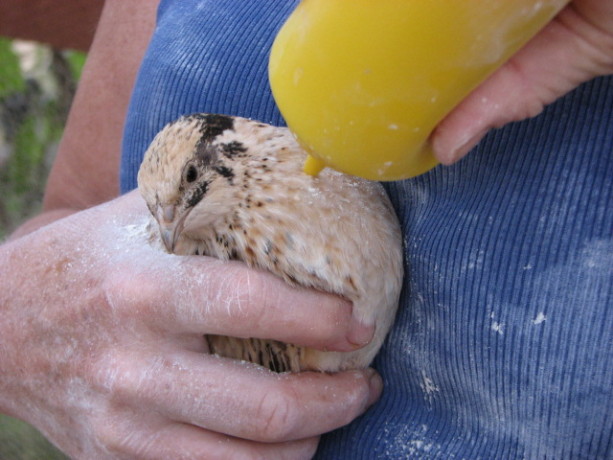
Miss Lemon, one of three coturnix hens, is treated with FGDE. You can buy pricey powder dispensers, which usually clog. I bought a set of mustard and ketchup dispensers for less than two dollars and they work just fine. We caught all the hens and our three quail and puffed FGDE into their feathers and, of course, all over ourselves.
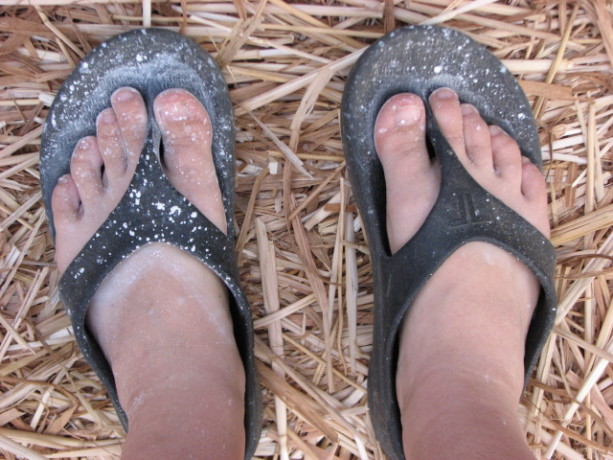
We treat ourselves, too. I puffed it into the nesting boxes, and into the ‘attic’ of the pullet house where they roost, and into the straw in the coops. Since we don’t have a problem we don’t need to treat often, just every few months or so. Any that they eat helps with any internal parasites as well. We also had some wood ash left over from making pizzas in Harry Mud the cob oven and sprinkled them where the birds take dust baths. That fine ash helps to keep their feathers clean and keep away mites too.
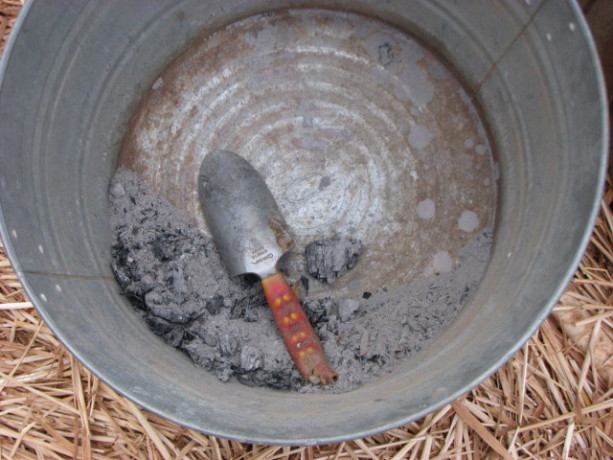
Wood ashes are good for dust baths. Very little went a long way, so even after treating all the hens and the Fowl Fortress, the cat bedding repeatedly, several cats, the feet of the bee hives, a variety of plants, and the feet of the food tables I’d set up for a garden party to protect from ants, along my window sills and around the privy where ants were getting in, I’m still working on the first bag that I bought on Amazon.com.
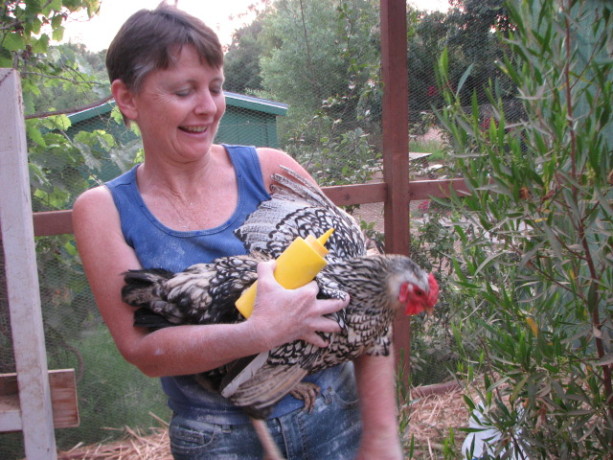
Amelia objecting to her dusting. When you compare with buying expensive different poisons for all of these problems, the health hazards and impact on non-target species including ourselves, and the negative impact on the Earth, one bag of FGDE is such a deal that you really can’t not try it.
-
Black Plum and Basil Granita
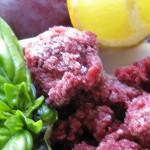 This is an interesting and delicious way to use some of those plums that ripen overnight. Basil is also in season, and combining it with the heavenly, winey flavor of ripe black plums is amazing. If you grow other types of basil such as lime basil or cinnamon basil, use those instead, reducing the lime juice to 1 tablespoon.
This is an interesting and delicious way to use some of those plums that ripen overnight. Basil is also in season, and combining it with the heavenly, winey flavor of ripe black plums is amazing. If you grow other types of basil such as lime basil or cinnamon basil, use those instead, reducing the lime juice to 1 tablespoon.Granita is juice that is partially frozen, forked around a little, then refrozen. You don’t need an ice cream maker. Easy, quick and nutritious, too!
Black Plum and Basil GranitaAuthor: Diane C. KennedyRecipe type: DesertCuisine: AmericanPrep time:Cook time:Total time:Serves: 8½ cup servingsBasil and allspice give a wonderful depth of flavor to winey black plums in this frozen treat.Ingredients- 1 cup water
- ⅔ cup granulated sugar
- ¼ teaspoon vanilla extract
- ⅛ teaspoon salt
- 6 whole allspice (if you don't have allspice berries, use a small piece of cinnamon stick)
- 1½ pounds black plums, pitted and quartered
- 2 tablespoons fresh lime juice
- ¾ cup basil leaves (not packed)
Instructions- In a large saucepan combine water, sugar, vanilla, salt, allspice and prepared plums and bring to a boil.
- Reduce heat and simmer for 15 minutes or so, stirring occasionally, until the plums begin to fall apart.
- Pour into a small bowl set in ice water in a larger bowl and cool completely.
- Fish out and discard the six allspice.
- In a blender or VitaMix process plum mixture, basil and lime juice until well blended.
- Press the plum mixture through a fine sieve over a bowl and discard solids. If you have a VitaMix you may not have any residual solids; the granita will be cloudier but will be more nutritious. Don't worry about it.
- Pour the mixture into an 8-inch square glass or ceramic baking dish.
- Cover and freeze until partially frozen, about 2 hours.
- Scrape with a fork, crushing any lumps, and smooth down again.
- Freeze for 3 more hours, scraping with a fork every hour so that it doesn't freeze as a cube, until completely frozen.
- Serve in small scoops; really nice paired with little vanilla cookies.
-
Going Pooless
I’ve been pooless for almost a week. I know, I know, who would have thought that I would do it? I’m sure if my friends knew, they wouldn’t know what to make of it. Even when my daughter called and I told her that I’d been pooless for several days, there was a surprised silence for several moments. In fact, I’ve been around friends, on a consultation job, and out shopping, and no one noticed. I was proud enough of my resolve to reveal my poolessness to a group of teachers who had just completed a 2-hour tour of Finch Frolic Garden last Saturday. After all the cool permaculture things I’d been showing them, their looks of astonishment were no surprise to me.
Why have I gone pooless? Because I’ve heard about how good it is for your skin, your hair and how it combats allergies. It is also inexpensive and easy on the greywater system.
Going without shampoo has been an interesting experiment.
The term ‘going pooless’ was popularized by permies.com lecturer Paul Wheaton. He has a podcast and discussion board about it here if you’d like to hear his and a woman’s year-long account of going soapless, as well as many other comments from people who have been soapless, shampooless and deodorantless for years.
The reason for going pooless is that we shampoo far too much. Shampoo strips away all the natural oils along with the dirt, and then we put more (usually expensive) gook on our hair to make it soft and shiny again. All that gook has lots of harmful chemicals, additives and scents. Commercial shampoos and soaps are dramatically linked to exema and other severe skin problems, allergies, and even migraines. I know several people who have to have ultraviolet treatment on their skin to keep psoriasis in check. One of these people is a clean fanatic, and another dyes her hair and wears a lot of makeup and perfume. I’ve mentioned going pooless or soapless to several people with skin problems, but they’d rather go on doing what they’ve always been doing.
Last week a good friend cut my hair (for barter) and it is short. It had been long enough that I’d been using a little hairspray to keep it out of my face and even when I washed my hair there was a residual product feeling to it. I washed my hair with Dr. Bronner’s castile peppermint soap, and still feeling some product I rinsed with diluted apple cider vinegar. That left my hair soft and clean. I always wash my hair in my morning shower. I continued to do that but instead of using shampoo, just vigorously rinsed it with plain water. This was a challenging time to do this because we entered a heat wave with temperatures rising over 100F, and I gardened, weed-whipped and sweated all through it. I also have the tendency to run my fingers through my hair.
The first couple of days I noticed no difference in my hair after rinsing. Gradually over the weekend my hair began to feel heavier, but it didn’t look greasy (I have oily skin type). I had heard that some people with straight hair who went pooless actually ended up with wavy hair – this was a strong motivator for me, but I’m out of luck. Yesterday I worked in the morning for several hours in the heat outdoors with a hat on, then dragged myself through my shopping chores. I encountered some challenging people and wasn’t in a great mood in the evening. I really like clean hair, too, and my hair was going through the transition stage of adapting to natural oils. It didn’t feel right. So this morning I rinsed it as usual, but also used a very tiny bit of natural shampoo for a quick rinse. I felt guilty about abandoning my project, but when I got out of the shower my hair still felt as if the natural oils were there, but my hair felt lighter. I didn’t strip it, but probably got rid of some extra oil from the extremely hot days. There is an adjustment period with going pooless. After some time your hair adjusts to absorbing the natural oils and then levels out and looks and feels great. Many European women rinse their hair and rub olive oil into it, leaving it in their hair. Their hair is luxurious. Allowing your own body’s oil to do the same thing is even better.
The purpose of soap is just to break the surface tension of water (surfactant) so that water penetrates better. All the rest of the stuff in soap is extra. Some of it can be good, like the addition of oatmeal to soothe skin or pieces of lavender to exfoliate. Many plants – like soapwort – are surfactants. We don’t need to use the harsh chemicals that are in most soaps to do the job. In fact, we really don’t need the soap at all except occasionally. If you don’t want to just rinse your hair with water but would like a more natural solution, dissolve some baking soda in water and use that the way you would soap. Your hair will feel sticky and tangly. Then rinse your hair with diluted apple cider vinegar (or white vinegar). Your hair will be soft, shiny, smooth and lovely because the acid will have neutralized the alkaline baking soda. A vinegar rinse every now and then helps strip product out of your hair anyway.
Going without deodorant or soap are two other venues to investigate, especially if you have any kind of skin issues or recurring headaches. Read some of the testimonials on the permies.com podcast page, or elsewhere on the Internet. Or use more natural ingredients to see what works for you.
I will continue to go pooless, with an occasional light sudsing from a natural shampoo when I feel the need, but I’ll be careful not to strip out the natural oil. If anyone compliments me on my hair, I will be proud to advertise my poolessness!
-
Arthritis and Turmeric… What Helped For Me
I’ve had osteoarthritis in my hands for almost fifteen years. I blame all that weed-whipping, pick-axing clay soil, and carrying all the plastic grocery bags in all at once because, by God, I’m not going to make two trips! It has migrated to my back, feet, ankles, and by the way I’m feeling these days my hip. I’m 51 years old. I’m also going through those lovely years of change that women get to experience, which makes my memory more dicey than I’m comfortable with, and some of that is due to my bad back (which I’ve had since a fall on a tennis court when I was 10 snaked my back) and the way I hold all my tension in my shoulders and neck. I’m sure that the tension and slowing of blood circulation that happens between trips to the chiropractor makes me a little ditzier than usual, too.
I’ve been taking glucosamine and chondroiten since my hands first gave me trouble. It worked wonderfully for years, and I’m sure it still does. When I moved to this house – I did all the packing and moving for me and my children – I found that my hands hurt so badly from carrying boxes that I didn’t know how I was going to use unpack or go back to work after my week’s vacation was up. By taking glucosa mine and chondroiten my hands felt better within a couple of days and I was able to continue.
Move through time with me to 2011 when my permaculture garden was installed. I had to drag multiple lengths of water-filled hoses around, haul heavy pots of plants and trees, dig through heavy soil and pull weeds. After it was installed, the next year, I had to dig out the huge rootballs of invasive bamboo that had been planted and replant trees, all of which had been planted deeply in clay inside gopher cages. Oh, and pull weeds. Lots of weeds. Glucosamine and chondroiten weren’t helping with the inflammation, just the lubrication of the joints. My hands hurt so badly that I was in crisis mode, wondering how I was ever going to keep the garden going when I couldn’t even use my hands for a day after pulling weeds. I’d wake up and my hands would be locked partially closed. I’d have to force them open, the fingers clicking as they ratcheted up, and then work them until the joints lubricated. My back hurt a lot. My mind was often in a fog and taking ginko biloba helped only a little. I became very depressed, wondering how life was going to be for me when at fifty I was in that bad a shape, and longevity (but not mental clarity!) was on my mother’s side.
I’d been taking a healing yoga class, and added that when I could two fitness classes a week at the marvelous Wade Into Fitness classes at the local community center. The gentle yoga practice kept me limber and steady, and helped me keep working, yet the artritis pain was still there.
As usual, I already knew the answer but didn’t realize it. I learned from MindZymes.com that the curcumin in turmeric, a spice used in curries, was an anti-inflammatory, so I’d been sprinkling it on my food. Using a lot tastes very bitter and the spice doesn’t go with everything. I’d read that black pepper helps to increase the absorption so I paired them together. No breakfast egg went eaten without being turned yellow and black. Then one day I researched turmeric thoroughly. Turmeric is prescribed by doctors in India like a drug, yet it is completely natural. The warnings for using it include that it may thin blood, may interfere with gall bladder (I had mine out a few years ago), and it hasn’t been tested (in the US) enough to be sure that it is safe for pregnant and lactating women. I read that all illness involves inflammation. Taking an anti-inflammatory can help with all illnesses. Wow. Sprinkling turmeric on my food was fine, but it wasn’t a large enough dosage to help with the inflammation I already had; I’d have to take capsules.
I was skeptical but I was ready to try anything rather than get shots from the doctor, or give up my activities. I’d just invested in this wonderful garden and I could hardly work in it. I bought turmeric capsules at a local herb store. It included phosphatidylcholine, which is a vital component of the human cell membrane and has been proven to play a vital role in our health, including maintaining cell structure, fat metabolism, memory, nerve signalling and liver health. the curcumin in turmeric is difficult for the body to absorb on its own, so the phosphatidylcholine helps increase the absorption by 70%. No, I didn’t know any of this before, I looked it up.
Last September I included the capsules with my daily vitamins and didn’t really think about them anymore. Within a few weeks I realized that when I awoke my hands weren’t stiff and stuck into position anymore. In fact, they didn’t even ache much after a day of weeding. The arthritis would cause shots of pain radiating from a knuckle down a finger like a lightening bolt, coming on without warning and making me gasp, something not fun when out in public. I realized I hadn’t had any of those surprise episodes for awhile. I also realized that when I went to my memory banks to search for a name, often I’d come up with it right away. My memory has never been perfect, but it was functioning better than it had and I felt less stupid and old. The reason for these miracles had to be the turmeric, because nothing else in my diet had changed. I continued taking it, and tested myself. I’d pull weeds, carry groceries and wake up the next morning with only the usual middle-aged aches and pains.
It has been nine months that I’ve been taking turmeric with phosphatidylcholine and every morning I wake up wondering if the spell has been broken. But it hasn’t. I even weed whip for hours and although I’m sore the next day, my hands aren’t locked and they are fully usable. Turmeric isn’t a miracle herb as such; there is no such thing. I still take a minute to loosen up my ankles and back when I get up in the morning, and heaven knows my memory makes conversations with other middle-aged people an exchange of “Um… you know… that thing…”; often more like charades than a dialogue. I still have to be careful and pace myself because the arthritis is still there. However I’m functioning far better than I was a year ago. My hands work!
I’ve recommended turmeric to lots of people, and I’ve had a couple of them tell me that they’ve found improvement since taking it. As I said, I was skeptical when I started and the relief I’ve had is frankly wondrous to me. It is not a cure-all, but as an anti-inflammatory it really worked for me.
I do not have anything to do with the company whose brand I buy; I simply bought what was available locally and it worked so I haven’t tried others. I’ve since begun buying it on the Internet because the local store stopped carrying that brand due to a contract dispute or something (of course!), and I get it for much less cost that way. Again, I receive nothing for recommending the brand, but what I’ve been taking is Source Naturals Meriva Turmeric Complex. Meriva is their trademark name for the phosphatidylcholine. I buy it from AmazonSmile.com (where you can designate a charity to receive a very small donation with every purchase), and found a deal for two bottles for a great price.
Anyway, since this really worked for me, I’m passing on my experiences in hope that maybe it can help you, too. Be sure to research turmeric for yourself to make sure that it doesn’t have any interference with problems you may have, and see what the health practitioners in India have to say about it.
And may all your weeds jump out of the ground at your feet!
UPDATE: It is March, 2017, and I’m still taking this turmeric with excellent results. If I over use my hands I’ll take two capsules in the morning. I switched to another brand that didn’t have the gel caps (I’m vegetarian), and it had a different mixture of turmeric, and within a week I was getting shooting pains in my fingers. I quickly switched back to this brand and the pains stopped. I don’t get anything from this company, I just know that this brand works for me. I use a gas weedwhip for hours, pull weeds, and recently bought a battery pole chainsaw which really taxed my hands and arms, and I’m not suffering from it, all due to the turmeric.







